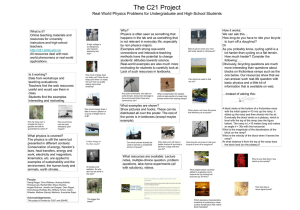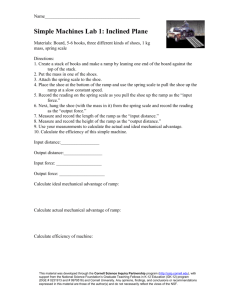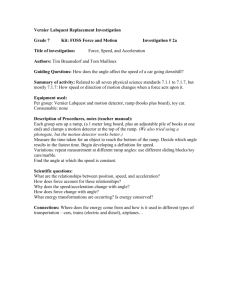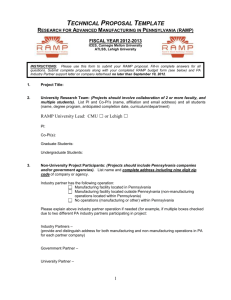Median Crossovers and Ramp Connections
advertisement
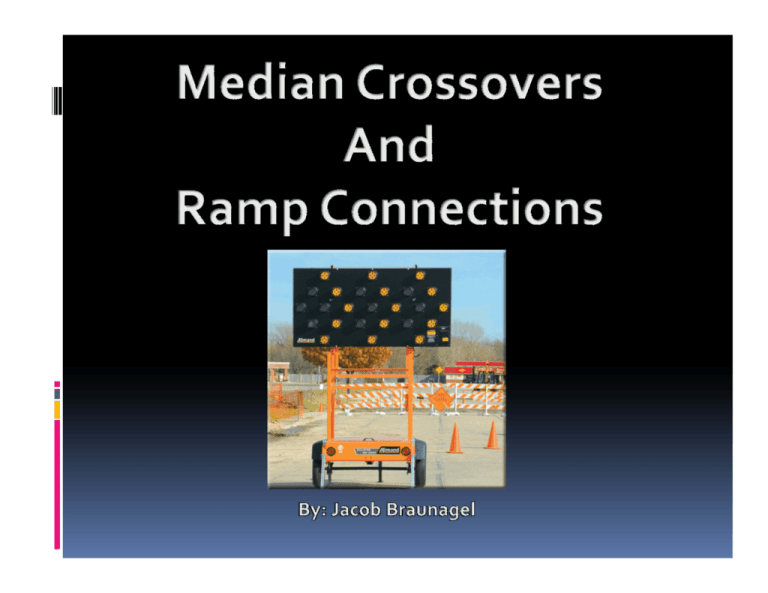
Used to transfer traffic across a median from one way traffic into head‐to‐head traffic. Frees roadway of traffic for construction. Designed with Asphalt or Portland Cement Concrete depending on length of time it is used and predicted traffic volume. Two general types of crossovers à Single Crossover à Double Crossover The posted speed limit for a median crossover is 40 MPH. The crossover curve must be designed according to the posted speed. Designing the curve consists of calculating the correct curve length and radius for a safe, comfortable ride across the crossover. Formulas for these calculations can be found in the AASHTO Policy on Geometric Design of Highways and Streets Text. The NDDOT does not have an actual standard drawing, but there is a “standard” drawing being circulated that is accepted as normal procedure. This standard drawing allows the choice of a double or single median crossover. The design is than base on the distance from centerline to centerline of the roadways. The standard curve radius is accepted as 2,000 ft The taper length is determined by the direction the traffic is entering onto the crossover A joint detail layout is also included in this standard drawing. A lane width of 12’ must be established with 10’ from the centerline to the edge of the pavement or concrete. Another factor is location: à Ideally a crossover should be placed on a straight section of roadway with a slope. à This allows for proper sight distance, with less change of slope due to superelevation, and also drainage of the median crossover. à If this is not possible the installation of drainage pipes may be needed. Usually selected when the crossover is to be used on two separate projects. Allows traffic to be transferred in four different ways as needed for the given construction zone. Usually constructed using Portland Cement Concrete due to extended use. There is no standard for the slope on a median crossover. In order for run‐off the crossover is sloped to the center of the median. This slope is designed individually for each specific case to allow for proper run‐off on each specific median crossover. Slope is designed for a smooth transition from the roadway to the median crossover. Usually Constructed for use on one construction project. Allows traffic to be transferred in two different ways as needed for the given construction zone. Usually constructed of Asphalt due to the short term use of the crossover. First the traffic is slowed to 65 MPH and a no passing zone is established using road signs. Next a sequencing arrow sign and a series of drums direct the traffic into the passing lane. The traffic is then slowed to 40 MPH before crossing the median crossover. Once the head to head traffic is established the speed limit changes back to 65 MPH and flexible delineators are used to separate the traffic. First the traffic is slowed to 65 MPH and a no passing zone is established using road signs. Next a sequencing arrow sign and a series of drums direct the traffic into the driving lane. The head to head traffic is then established and the speed limit remains at 65 MPH. The traffic is separated using flexible delineators. Used to transfer traffic across the construction zone while exiting an off‐ramp or entering an on‐ramp. Designed with asphalt or aggregate surfacing depending on the traffic volume and length of construction. The taper that the ramp leaves the traveled roadway depends on if the ramp is an on‐ramp or an off‐ramp. à Off‐Ramp – 40:1 Taper à On‐Ramp – 50:1 Taper The posted speed for a ramp connection is 45 MPH. The horizontal curve alignment must be calculated using the AASHTO text for a 45 MPH design speed. For ramps with a heavy traffic volume the ramp connection is designed with a full length asphalt ramp. Ramps with a minimal amount of traffic volume are designed with an asphalt taper. Once the taper provides the proper lane width an aggregate surfacing is used for the remainder of the ramp connection. There is not a standard drawing for ramp connections. The best design principle is to research past designs. Depending on the construction phasing the ramp conection will need to be removed at some time for construction of the mainline. A temporary bypass , usually all aggregate, is than constructed in order to maintain traffic flow. This temporary bypass either takes traffic over a finished portion of the mainline or further ahead of the reconstruction zone until the portion of the mainline containing the connection is finished. In order for a smooth transition the shoulders of the mainlines are usually removed. If the shoulder is relatively new the connection is than butted up to the shoulder. The ground and aggregate below the shoulders is also removed to assure a steady base for the ramp connection. Once the ramp connection is removed the base and shoulders of the mainlines are replaced.

